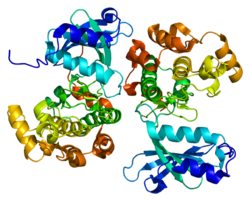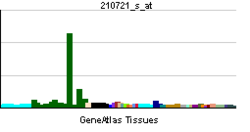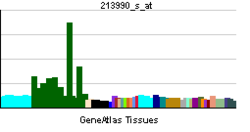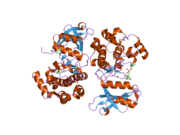- PAK7
-
P21 protein (Cdc42/Rac)-activated kinase 7 
PDB rendering based on 2f57.Available structures PDB 2f57 Identifiers Symbols PAK7; KIAA1264; MGC26232; PAK5 External IDs OMIM: 608038 MGI: 1920334 HomoloGene: 22211 GeneCards: PAK7 Gene EC number 2.7.11.1 Gene Ontology Molecular function • nucleotide binding
• protein serine/threonine kinase activity
• protein binding
• ATP bindingCellular component • mitochondrion Biological process • protein amino acid phosphorylation
• anti-apoptosisSources: Amigo / QuickGO RNA expression pattern 

More reference expression data Orthologs Species Human Mouse Entrez 57144 241656 Ensembl ENSG00000101349 ENSMUSG00000039913 UniProt Q9P286 Q4KL59 RefSeq (mRNA) NM_020341.3 NM_172858.2 RefSeq (protein) NP_065074.1 NP_766446.2 Location (UCSC) Chr 20:
9.52 – 9.82 MbChr 2:
135.91 – 136.21 MbPubMed search [1] [2] Serine/threonine-protein kinase PAK 7 is an enzyme that in humans is encoded by the PAK7 gene.[1][2][3]
The protein encoded by this gene is a member of the PAK family of Ser/Thr protein kinases. PAK family members are known to be effectors of Rac/Cdc42 GTPases, which have been implicated in the regulation of cytoskeletal dynamics, proliferation, and cell survival signaling. This kinase contains a CDC42/Rac1 interactive binding (CRIB) motif, and has been shown to bind CDC42 in the presence of GTP. This kinase is predominantly expressed in brain. It is capable of promoting neurite outgrowth, and thus may play a role in neurite development. This kinase is associated with microtubule networks and induces microtubule stabilization. The subcellular localization of this kinase is tightly regulated during cell cycle progression. Alternatively spliced transcript variants encoding the same protein have been described.[3]
Interactions
PAK7 has been shown to interact with CDC42.[1][4]
References
- ^ a b Dan C, Nath N, Liberto M, Minden A (Dec 2001). "PAK5, a new brain-specific kinase, promotes neurite outgrowth in N1E-115 cells". Mol Cell Biol 22 (2): 567–77. doi:10.1128/MCB.22.2.567-577.2002. PMC 139731. PMID 11756552. http://www.pubmedcentral.nih.gov/articlerender.fcgi?tool=pmcentrez&artid=139731.
- ^ Nagase T, Ishikawa K, Kikuno R, Hirosawa M, Nomura N, Ohara O (Jan 2000). "Prediction of the coding sequences of unidentified human genes. XV. The complete sequences of 100 new cDNA clones from brain which code for large proteins in vitro". DNA Res 6 (5): 337–45. doi:10.1093/dnares/6.5.337. PMID 10574462.
- ^ a b "Entrez Gene: PAK7 p21(CDKN1A)-activated kinase 7". http://www.ncbi.nlm.nih.gov/sites/entrez?Db=gene&Cmd=ShowDetailView&TermToSearch=57144.
- ^ Pandey, Akhilesh; Dan Ippeita, Kristiansen Troels Z, Watanabe Norinobu M, Voldby Jesper, Kajikawa Eriko, Khosravi-Far Roya, Blagoev Blagoy, Mann Matthias (May. 2002). "Cloning and characterization of PAK5, a novel member of mammalian p21-activated kinase-II subfamily that is predominantly expressed in brain". Oncogene (England) 21 (24): 3939–48. doi:10.1038/sj.onc.1205478. ISSN 0950-9232. PMID 12032833.
Further reading
- Jaffer ZM, Chernoff J (2002). "p21-activated kinases: three more join the Pak.". Int. J. Biochem. Cell Biol. 34 (7): 713–7. doi:10.1016/S1357-2725(01)00158-3. PMID 11950587.
- del Peso L, González-García M, Page C, et al. (1997). "Interleukin-3-induced phosphorylation of BAD through the protein kinase Akt.". Science 278 (5338): 687–9. doi:10.1126/science.278.5338.687. PMID 9381178.
- Scheid MP, Schubert KM, Duronio V (1999). "Regulation of bad phosphorylation and association with Bcl-x(L) by the MAPK/Erk kinase.". J. Biol. Chem. 274 (43): 31108–13. doi:10.1074/jbc.274.43.31108. PMID 10521512.
- Tan Y, Demeter MR, Ruan H, Comb MJ (2000). "BAD Ser-155 phosphorylation regulates BAD/Bcl-XL interaction and cell survival.". J. Biol. Chem. 275 (33): 25865–9. doi:10.1074/jbc.M004199200. PMID 10837486.
- Lizcano JM, Morrice N, Cohen P (2001). "Regulation of BAD by cAMP-dependent protein kinase is mediated via phosphorylation of a novel site, Ser155.". Biochem. J. 349 (Pt 2): 547–57. doi:10.1042/0264-6021:3490547. PMC 1221178. PMID 10880354. http://www.pubmedcentral.nih.gov/articlerender.fcgi?tool=pmcentrez&artid=1221178.
- Cau J, Faure S, Comps M, et al. (2002). "A novel p21-activated kinase binds the actin and microtubule networks and induces microtubule stabilization.". J. Cell Biol. 155 (6): 1029–42. doi:10.1083/jcb.200104123. PMC 2150914. PMID 11733543. http://www.pubmedcentral.nih.gov/articlerender.fcgi?tool=pmcentrez&artid=2150914.
- Deloukas P, Matthews LH, Ashurst J, et al. (2002). "The DNA sequence and comparative analysis of human chromosome 20.". Nature 414 (6866): 865–71. doi:10.1038/414865a. PMID 11780052.
- Pandey A, Dan I, Kristiansen TZ, et al. (2002). "Cloning and characterization of PAK5, a novel member of mammalian p21-activated kinase-II subfamily that is predominantly expressed in brain.". Oncogene 21 (24): 3939–48. doi:10.1038/sj.onc.1205478. PMID 12032833.
- Strausberg RL, Feingold EA, Grouse LH, et al. (2003). "Generation and initial analysis of more than 15,000 full-length human and mouse cDNA sequences.". Proc. Natl. Acad. Sci. U.S.A. 99 (26): 16899–903. doi:10.1073/pnas.242603899. PMC 139241. PMID 12477932. http://www.pubmedcentral.nih.gov/articlerender.fcgi?tool=pmcentrez&artid=139241.
- Cotteret S, Jaffer ZM, Beeser A, Chernoff J (2003). "p21-Activated kinase 5 (Pak5) localizes to mitochondria and inhibits apoptosis by phosphorylating BAD.". Mol. Cell. Biol. 23 (16): 5526–39. doi:10.1128/MCB.23.16.5526-5539.2003. PMC 166342. PMID 12897128. http://www.pubmedcentral.nih.gov/articlerender.fcgi?tool=pmcentrez&artid=166342.
- Ota T, Suzuki Y, Nishikawa T, et al. (2004). "Complete sequencing and characterization of 21,243 full-length human cDNAs.". Nat. Genet. 36 (1): 40–5. doi:10.1038/ng1285. PMID 14702039.
- Matenia D, Griesshaber B, Li XY, et al. (2006). "PAK5 kinase is an inhibitor of MARK/Par-1, which leads to stable microtubules and dynamic actin.". Mol. Biol. Cell 16 (9): 4410–22. doi:10.1091/mbc.E05-01-0081. PMC 1196348. PMID 16014608. http://www.pubmedcentral.nih.gov/articlerender.fcgi?tool=pmcentrez&artid=1196348.
- Rual JF, Venkatesan K, Hao T, et al. (2005). "Towards a proteome-scale map of the human protein-protein interaction network.". Nature 437 (7062): 1173–8. doi:10.1038/nature04209. PMID 16189514.
- Cotteret S, Chernoff J (2006). "Nucleocytoplasmic shuttling of Pak5 regulates its antiapoptotic properties.". Mol. Cell. Biol. 26 (8): 3215–30. doi:10.1128/MCB.26.8.3215-3230.2006. PMC 1446938. PMID 16581795. http://www.pubmedcentral.nih.gov/articlerender.fcgi?tool=pmcentrez&artid=1446938.
- Ewing RM, Chu P, Elisma F, et al. (2007). "Large-scale mapping of human protein-protein interactions by mass spectrometry.". Mol. Syst. Biol. 3 (1): 89. doi:10.1038/msb4100134. PMC 1847948. PMID 17353931. http://www.pubmedcentral.nih.gov/articlerender.fcgi?tool=pmcentrez&artid=1847948.
PDB gallery Categories:- Human proteins
- Chromosome 20 gene stubs
Wikimedia Foundation. 2010.

